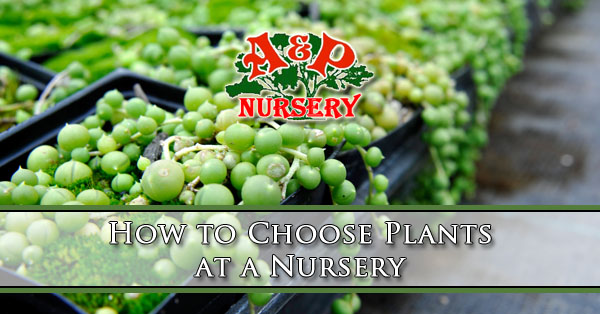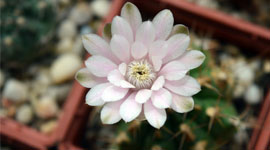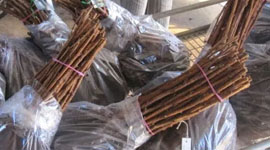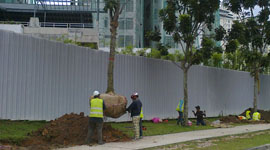
If you are searching for “How to Choose Plants at a Nursery” you are looking to find information about how to get the biggest bang for your gardening buck. People who love gardening love browsing through nurseries. We want to share with you how to get the most for your money and make the best use of your time.
Ways Plants are Packaged at Nurseries
As gardeners browse through the nursery its easy to notice that plants are sold in 3 main forms: containers, bare-root, and balled and burlapped. The way that plants are sold is usually related to their size and type of plant. Plants that are sold with bare roots are typically roses and hedge plants. The plants that are sold in containers are usually smaller plants like small trees, shrubs, and bedding plants. Burlapped root plants are normally the largest plants like trees and large shrubs.
How Nursery Plants are Grown
Bare-root, container, and burlap packaged plants are grown in fields where nurseries can better manage their growth, nourishment, and allow for more aggressive growth.
Small Container Plants
 These smaller plants start life and grow in containers and continue to grow in progressively larger containers. Some container plants are pretty expensive as there is cost involved in investing in larger and larger containers as the plants grow through the years of maturing. A good example of this is the dwarf conifer, they are notoriously slow to grow. It takes several years for them to grow big enough to be sold.
These smaller plants start life and grow in containers and continue to grow in progressively larger containers. Some container plants are pretty expensive as there is cost involved in investing in larger and larger containers as the plants grow through the years of maturing. A good example of this is the dwarf conifer, they are notoriously slow to grow. It takes several years for them to grow big enough to be sold.
Bare-Root Plants
 During the cooler parts of the year nurseries offer bare-root plants, such as roses or lilacs. This is the time of year where they won’t begin to grow before being planted. Some nurseries keep bare-root plants in suspended animation by keeping them in cold storage. Being able to purchase your bare-root plants at your local nursery does help avoid fungal diseases that can cripple your plants.
During the cooler parts of the year nurseries offer bare-root plants, such as roses or lilacs. This is the time of year where they won’t begin to grow before being planted. Some nurseries keep bare-root plants in suspended animation by keeping them in cold storage. Being able to purchase your bare-root plants at your local nursery does help avoid fungal diseases that can cripple your plants.
Large Burlapped Plants
 Nurseries typically grow shrubs and trees in fields where the plants are able to grow to larger sizes and are easier to maintain. The stock grown in the field needs to be dug up in winter and early spring while the plants are dormant. After they are dug up the larger plants get the roots wrapped in burlap and twine. The largest trees many times also end up having metal cages used. Large trees that are for sale at nurseries lose a portion of their roots when dug up and package, but this is the only way to get a larger specimen.
Nurseries typically grow shrubs and trees in fields where the plants are able to grow to larger sizes and are easier to maintain. The stock grown in the field needs to be dug up in winter and early spring while the plants are dormant. After they are dug up the larger plants get the roots wrapped in burlap and twine. The largest trees many times also end up having metal cages used. Large trees that are for sale at nurseries lose a portion of their roots when dug up and package, but this is the only way to get a larger specimen.
Selecting Nursery Plants
Every gardener in Arizona wants to get the most for their money, and the healthiest plants for their landscape. The following will help you get the best stock and best fit for your home and landscape.
Signs To Look For
When you have a nice selection of plants you can learn a lot just by comparing the available plants. For example let’s say you are thinking about buying a river birch and there is a wide selection of plants. All of them are about the same height and are maturing by showing substantial trunks and peeling of the bark. The price per tree is all about the same and although aren’t cheap they offer immediate landscaping cover from a more mature tree.
Things to keep in mind while you are comparing a tree like this, or any plant, are things like how many trunks or stalks they have, the condition of the leaves, smaller root balls, or roots that are exposed and look distressed or dried out. Some plants like the river birch have a classic look like those with 3 trunks. The leaves shouldn’t be yellowing as this can be an indication that it is nitrogen starved. Smaller root balls typically mean either drought or poor quality soil they were grown in. Look for signs of poorly maintained stock and only buy the best that is on display.
- Configuration of plant
- Condition of leaves and roots
- Size of root balls
- Overall maturity of the plant
Getting The Best Fit
Landscaping relates to architecture and the trees you plant shouldn’t be too small or too big for your home or business. The scale of you tree should stay to within 1/3rd to 1/4th taller than your home. If it is too much taller it will dwarf your house. Ranch style homes that are one story should consider trees that grow to no more than 15 to 20 feet in height. Two story homes can go bigger and allow for trees that mature to be 22 to 30 feet in height. It is best to plant the biggest trees at the edges of your property to avoid overpowering your home. This keeps them away from the house, and it is best to think ahead if there are power lines.
Getting Your Plants Home
If you aren’t taking advantage of delivery and planting from your nursery you need to know the best way to transport your plants home. If you are taking the plants home yourself in your vehicle make sure you have a tarp to cover them and some rope to secure them. The wind from driving can seriously damage or even kill your plants so make sure you have them covered, even if it is a short distance home. One example of tree that is especially sensitive to wind and dehydration is the evergreen, it simply cannot tolerate dehydration of the needles.
East Phoenix Valley Nurseries
Residents of Mesa, Queen Creek, Gilbert, and the whole East Phoenix Valley have 4 A&P Nursery locations to choose from for the best plants, knowledgeable staff, and friendly service. Delivery and planting services are available through a network of trusted landscapers, so you can rest assured that your landscape will look great with your new plants. Call or stop by one of our locations today!
A & P Nursery
40370 N. Gantzel Rd.
Queen Creek, AZ 85240
480-655-5789
A & P Nursery
2645 W. Baseline Rd.
Mesa, Arizona 85202
480-839-5362
A & P Nursery
6129 E. Brown Rd.
Mesa, Arizona 85205
480-396-8800
A & P Nursery &
Lawnmower Shop
2601 E. Baseline Rd.
Gilbert, Arizona 85234
480-892-7939